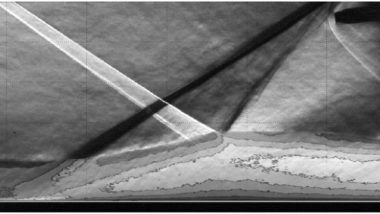Unsteadiness in separated shock–boundary layer interactions have been previously analysed in order to propose a scenario of entrainment–discharge as the origin of unsteadiness. It was assumed that the fluid in the separated zone is entrained by the free shear layer formed at its edge, and that this layer follows the properties of the canonical mixing layer. This last point is addressed by reanalysing the velocity measurements in an oblique shock reflection at a nominal Mach number of 2.3 and for two cases of flow deviation (8 ◦ and 9.5 ◦ ). The rate of spatial growth of this layer is evaluated from the spatial growth of the turbulent stress profiles. Moreover, the entrainment velocity at the edge of the layer is determined from the mean velocity profiles. It is shown that the values of turbulent shear stress, spreading rate and entrainment velocity are consistent, and that they follow the classical laws for turbulent transport in compressible shear layers. Moreover, the measurements suggest that the vertical normal stress is sensitive to compressibility, so that the anisotropy of turbulence is affected by high Mach numbers. Dimensional considerations proposed by Brown & Roshko (J. Fluid Mech., vol. 64, 1974, 775–781) are reformulated to explain this observed trend.
Voir l'article sur HAL: https://hal.archives-ouvertes.fr/hal-01454909v1


